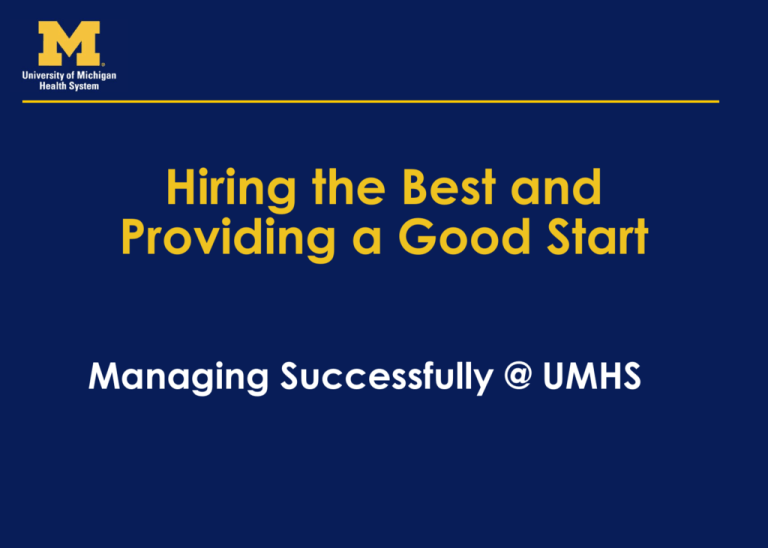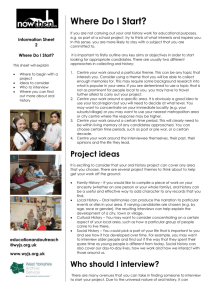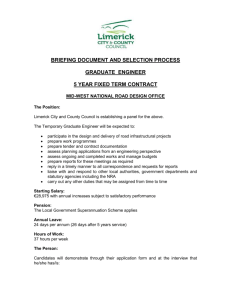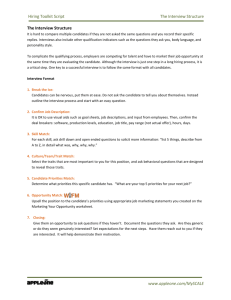Sample Talk
advertisement

Hiring the Best and Providing a Good Start Managing Successfully @ UMHS Overview Purpose: Understanding & awareness of recruitment, selection & orientation practices; learn skills for a successful hiring process; become acquainted with UMHS resources Learning Objectives: • Analyze department needs • Write accurate job descriptions • Develop recruitment strategies • Write effective interview questions • Analyze and screen resumes • Learn how to conduct reference checks • Develop an orientation plan • Resources Limit: 4 hours Pg. 1 Attract/Recruit • Job Descriptions • Selection Criteria • Where to post/advertise Selection Process • Screening Resumes • Interview • Selection of Applicant Orientation/Orientation • Central orientation • Department orientation • Ongoing onboarding Key UMHS Human Resource Contacts Key Players • HR Business Partners/ HR Business Unit • Workforce Planning Specialists • Findly (Recruitment and Advertising) Pg. 3 Hiring Process Exercise Purpose: To become familiar with the steps of the hiring process. Agenda: Sort the index cards in the appropriate order to describe the hiring process. Limit: 5 minutes Steps in the Process • • • • • • • • • • Identify a need Develop a job description Candidate sourcing (find candidates) Screen resumes Select who to interview Interview candidates Select candidate Check references Make the offer Orient new employee Attract/Recruit Your Responsibility for ensuring a Fair and Equitable Hiring Process Ways to implement fair and equitable hiring practices: • Encourage diverse people to apply • Provide reasonable accommodation • Remove bias from interviewing methods • Keep inquiries and questions job-related • Be consistent with all candidates • Select the best qualified candidate Pg. 4 Determining Qualifications • Don’t over qualify! • Department qualifications – Example: Proficient word processing skills • Department desired qualifications – Example: Microsoft Office experience Pg. 7 Developing Selection Criteria • • • • • • • • Guides supervisor in determining which candidates meet qualifications Establish before position advertised or posted Clearly defined and relevant to the position Used to evaluate applicants for the position after the initial screening Relevant, understandable, defensible Align with department needs Based on department minimums Document how decision is made Pg. 8 Developing Selection Criteria Generally, you will have at least four to six selection criteria set for your position • Make sure that the criteria is job-specific KSAs needed to undertake the duties of the position successfully • Categories to think about: – Knowledge – Skills and Abilities – Education – Professional Designations – Experience • Pg. 8 Selection Criteria Exercise Purpose: To understand how to develop selection criteria Agenda: Review the job description you brought with you today. Think of what selection criteria you are currently using and determine if you need to add any additional criteria. Limit: 10 min. Pg. 9 Candidate Sourcing Tips • Think like a coach • Places to recruit • Attend job fairs / networking events at Colleges/Universities • Create internships &/or part-time positions • Write position descriptions to attract diverse candidates • Utilize faculty, students, physicians, staff Pg. 10 Job Posting Exercise • Review the sheet on Avoiding Discrimination in Job Postings. • Identify 2 “issues” in each of the 4 statements that could be discriminating if posted • Please re-write the statement to remove the discriminative wording Selection Process Reviewing the Candidate Pool • Do you have a diverse pool? • Critical that job pools are as diverse as possible • Do you have RIF candidates? • Obligation to candidates who have been RIF’d • Healthcare Source Assessment – SRC Pg. 12 Vendor: HealthcareSource® • Pre-Employment Assessment • Reference Assessment • Leadership Assessment • Integration with ATS (eRecruit) http://www.brainshark.com/healthcaresource/Staff-Assessment-Tour?dm=1 Vendor: HealthcareSource® • Five Job Families – Nursing – Patient Care – Entry-Level Service – Administrative/Clerical – Technical/Professional Affirmative Action and Diversity • What does a goal represent? • What should you do when you have a goal? • Difference between Affirmative Action and Diversity • How to develop a diverse staff Pg. 14 Screening Resumes • Prepare thoroughly • Think how the candidate adds to or enhance diversity • Identify key qualifications • Focus on qualifications related to essential tasks • Be wary of sloppiness • Identify and discuss gaps in employment • Look for length of time in various positions • Do not read anything into the resume Pg. 13 Screening Resumes • Review all applicants to see if they met the minimal qualifications • Focus on key selection criteria set – – – Qualified Possible Qualified Not Qualified • Remember when reviewing applicants – remove biases • Prescreen telephone interviews Pg. 13 Activity: Would You Ask These Questions? Purpose: To practice reviewing legal and illegal questions Agenda: Complete the sheet of questions. Follow the directions of the instructor. Limit: 15 minutes Pg. 15-16 Appropriate Questions Appropriate questions are: • Legal and job-related • Objective Illegal questions not to ask about: • Identity • Race or national origin • Residence • Citizenship • Child care • Disability Pg. 17 The Interview Guide • Opening • Transition to interview • Overview • Education, Experience, Knowledge, Skills • Behavior • Interests • Strengths and Areas for Improvement • Sharing • Transition to close • Close Pg. 18-19 Hiring The Best Online Wiki What is a Wiki? • Hiring the Best Online Wiki • Pg. 20 Using the Interview Guide Purpose: To become familiar with the Interview Guide. Agenda: 1. Review the Interview Guide 2. Discuss these questions: Is anything missing? What would you add? Is anything wrong or objectionable? 3. Debrief with entire class Tips to Prepare for the Interview • Develop structure of process and norms and follow uniformly • Decide what will be required from candidates – Work sample vs. testing vs. something else • Allow adequate time • Base interview questions on selection criteria • Selection criteria based on job description and posting • All questions job related and written before interviews • Interview sheets for each interview team member Pg. 25 Things to Keep in Mind Develop a tolerance for silence. Keep candidates informed. Keep notes on all the candidates. Debrief right after each interview when using teams. Pg. 24 Types of Interview Questions • Traditional – Straight forward answers • Behavior Based & Competency – Provides insight on how interviewee acted or will behave in the future – Requires interviewee to give specific examples in which they demonstrated particular skills or attitudes • Organizational and Job Fit – Focuses on the likely fit with the job and organization Additional Interview Questions Retention or “Stay” questions to ask candidates during the interview? • What are some of the key factors that would keep you here if you got the job? • What might entice you away? • What would keep your energy up? Pg. 24 Behavioral Based Interviewing VIDEO CLIP Writing Behavioral Based Interview Questions • Highlight the competencies and behaviors associated with the job and skills needed • Samples of how behavioral based questions may start: – Tell me about a time… – What strategies have you used… – Give me an example… – Describe a decision/situation…. – How did you respond… – What would you do if… Developing BehaviorallyBased Interview Questions Purpose: Practice developing behaviorally-based interview questions Agenda: 1. Refer to job description and selection criteria. 2. Using the information given to you by the instructor, develop behaviorallybased questions. 4. Share with larger group. Pg. 27 Behavioral Based Interview Practice Purpose: To practice conducting behavioral-based interviews. Agenda: 1. Form triads and select an interviewer, interviewee and an observer 2. Conduct a mock interview using the behavioralbased interview questions developed (3-4 questions total) Debrief as a large group 1. Share observations and response to the following question: What would you do differently? Preparing for the Interview • Develop a structured and standardized interview plan • Typical Interview Structure: – Opening – 5% – Job/Organizational Culture – 10% – Question/Information Gathering – 75% – Candidate Asking Questions – 5% – Wrap/Up Overview of Next Steps – 5% • Think about some answers you may receive and any follow-up questions the applicant may ask, this will prepare you for what may need to be addressed Evaluation and Analyzing Answers during Interview • STAR Method* – – – – • S – Situation T – Task A – Action Taken R – Results of Outcome Good answers to behavioral questions should specifically describe a situation or task, outline the actions taken and summarize the outcome *Source – Alan De Back – Career Management International Interviewing Techniques and Tools Information you should supply to the candidate: • Manager and supervisor(s) names • Location & working conditions • Who employee supervises, what level(s) (if applicable) • Job tasks • Education, experience, knowledge and skills needed • Behaviors needed to be successful • Benefits of the position • How many interviews will they have to go through? • When will they hear back? Pg. 29 Selection Guidelines • Based upon objective, job related factors • Choose candidates with complementary interests, skills, etc. • Review reasons for choosing or not choosing a candidate • Reflect upon your decision for a few days • Complete the process before making final offer • Consider transferable skills • Use standard method for selection and reference checking • Reflect on biases and how they influenced decision • Document entire process. Pg. 30 Inclusionary Selection Techniques Key items to remember when looking for candidates: • Practice inclusion. Think about how you define “best.” • Don’t label “best” or “worst” until all candidates are seen • Don’t assume! Ask the candidate about salary, being “the only,” moving, etc. • Examine behaviors to make sure biases aren’t influencing selection decisions • Help candidates see how they will “fit” – Hiring the candidate who has complimentary experiences, interests, values and dimensions of Pg. 31-32 diversity Selling the Job Some things to tell candidates: • Summary of paid benefits • Generous time off and retirement package • Benefits of working at UMHS • Fast paced environment • We’re leaders in healthcare • Large, diverse place where a career can be built • Team environment • How the department is unique Pg. 33 A Few More Things To Remember • You Are Not Hiring: – For yourself – For individual faculty members – For research grants – For a friend • You Are Hiring: – To fulfill a University need – To meet Federal/State guidelines – To meet University needs today and in the future Pg. 34 “Great recruiting is not about hiring a large number of people or hiring them cheaply; it’s about hiring individuals who become top performers and who stay with the organization.” Dr. John Sullivan Pg. 34 Prospective Employee References • Why Do Them? • How to do them – Current UM employees – Outside candidates – You can call people who are not on the “reference list.” – The law is evolving – Gain confidence of reference person • Get other opinions if reference is problematic Pg. 35-36 Candidate Is Selected • Choose best qualified • Affirmative Action goals • Departmental diversity • Salary is Set – Before making an offer, obtain approval from the Employment Process Coordinator – He or she will review salary, goals, RIF’s to avoid potential pitfalls. Pg. 37 Extending the Offer • Get to the point! • Be enthusiastic • Give the candidate time to consider • Send to orientation Pg. 37 Onboarding/ Orientation Orientation • Before the new employee’s arrival • Within the first month – first day • Ongoing orientation Pg. 38-39 Orientation Within the first month – first day: – Welcome person with enthusiasm – Introduce to orientation buddy and colleagues – Double check to make sure all paperwork is completed – Give employee tour – Explain departmental policies and practices – Reintroduce the function of the department, their job, team assignments, key partners etc. – Orient to key assignments – At the end of the day, check to see if there are questions, etc. Pg. 38 Orientation The rest of the first month: – – – – Arrange for appropriate training Continue to introduce employee to key people Review performance standards Regularly check back for problems, questions, successes – Questions to ask yourself about the employee: • In what job area is he or she especially strong? • How well is he or she functioning so far in relation to others at this point? • What suggestions do you have for the new employee? • Are there things the department can do to assist the employee? • Are there areas that seem to need further clarification? Pg. 39 Retention • The ability to keep talented employees in the organization. – Involves strategic actions to keep high performers motivated and focused – Preserves and develops an organization's human capital – Reduces voluntary turnover costs • Retention Strategies – Socialization – Clear and Fair Supervision – Growth and Promotional Opportunities – Training and Development – Recognition – Clear and Consistent Job Expectations – Respect Pg. 40 Blue Folders – Requirements • • • • • Why do we have them? Different from Personnel Files How do you get one? Importance of completing when first on job What is/isn’t in it? www.med.umich.edu/umhshr/supervisor/bfb.htm Email: bfbrigade@med.umich.edu Pg. 40 New Hire Survey For all new hires: – All new hires receive survey – Survey ask questions about on-boarding and orientation (yes, they are different) – Survey sent via email at 90 days – Encourage employees to fill out Encouraging Career Development • Shared responsibility – Employee-Management-Organization Role of the Supervisor • Develop in or out of role • Why people come here • Resources Available • – Career Navigator – Career Development Website (VOICES) End of Day Activities End of Day Activities • Table Words – As a team share 2 key concepts, lessons learned, or actions you plan to take based on your table word – Leave table word cards in basket on table • Erase names • Remove trash from tables • Evaluations • Completely shut down netbooks before powering off






